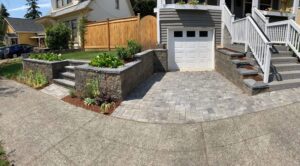Concrete retaining walls are a simple, aesthetically pleasing addition to any landscape. Due to their muted shades, they are able to match any landscape style and are one of the sturdiest retaining wall options.
If you are wondering how to form and pour a concrete retaining wall, continue reading or give New Life Rockeries a call to speak with our expert retaining wall contractors.
How to Pour a Concrete Retaining Wall
Here are five steps for how to pour a concrete retaining wall. If you have any questions about how to prepare your site for pouring a concrete retaining wall or how to pour a sturdier concrete retaining wall, give New Life Rockeries a call.
Before we get into the how-to section of pouring a concrete retaining wall, let’s first take a look at the tools you will need to do it.
Tools Needed to Pour a Concrete Retaining Wall
- Shovel
- Tamper
- Concrete mixer
- Stakes
- Wooden planks
- Measuring tape
- Post driver
Plan the Site –
Prepare the site where you plan on pouring your concrete retaining wall by marking out where the footings will be and measuring the area to ensure that you’ve purchased enough concrete and retaining wall materials.
Dig the Footing –
If you’re wondering how to pour a concrete footing for a retaining wall, this is where it starts. Using your shovel, dig the footing to the correct depth (the depth of your footing is determined by the chosen height of your concrete retaining wall).
Build the Forms –
When it comes to building the forms, the width of your concrete retaining wall as well as where you dug the footings will determine how to build the forms. Drive stakes into the ground using your footings as a guide, then use the stakes to build your forms.
Mix Your Concrete –
Now comes the fun part of pouring a concrete retaining wall — mixing the concrete.
Follow the directions detailed on the back of your cement bag to mix your concrete. Use a cement mixer to mix it thoroughly and then use your wheelbarrow to transfer your cement to the excavation site.
Pour Your Concrete Retaining Wall –
Pour your mixed concrete into the forms until they are filled with cement. Refer to the back of the cement bag to see how long you need to let the concrete dry for before removing the wooden forms (most cement will take about several days or even weeks to dry fully).
Need Help Pouring Your Concrete Retaining Wall?
We know that pouring a concrete retaining wall is a daunting task. If you want to eliminate the stress of pouring your own concrete retaining wall, work with a retaining wall contractor instead.
While DIY projects can be fun, they can also add large amounts of unnecessary stress and work. Rather than spending your next few weekends gathering the necessary materials and figuring out how to pour a curved small concrete retaining wall, why not give New Life Rockeries a call?
Here at New Life Rockeries we’ve been pouring concrete retaining walls and offering landscape services to homeowners for more than 35 years. Our team would be happy to help you design and pour a concrete retaining wall to make your landscape more practical and beautiful.
To learn more about our retaining wall services, give New Life Rockeries a call today.




